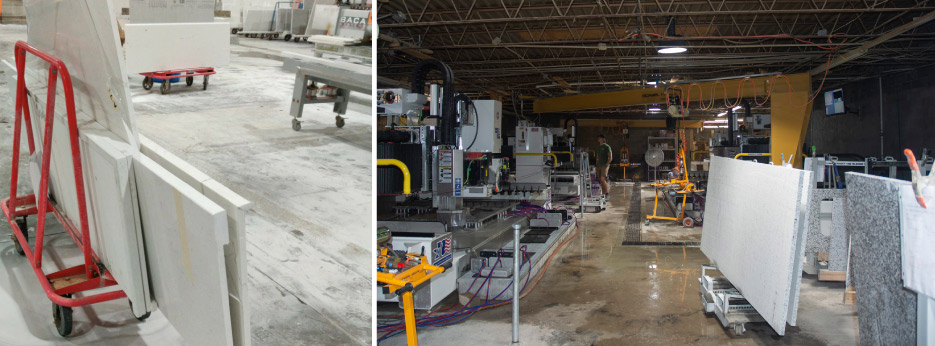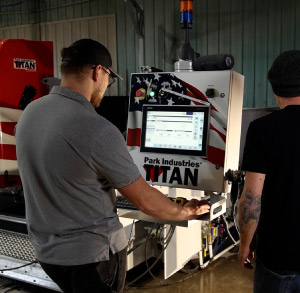Roger and His Fabrication Shop
A True Story of Saving a Failing Business
Rick Phelps
Synchronous Solutions
Roger was stressed out. His family countertop fabricating business was not making a profit, and hadn’t for some time. A lot was riding on his ability to make the business work – five direct family members were employed by his company, and they were counting on him. So were 25 other employees, who were like family to him. There was plenty of business, but it just wasn’t profitable enough to justify the investment, the risk and the stress on all the employees.
Roger worked with his accountant every week to identify how to squeeze costs and eke out enough cash to pay the bills. They were also strategizing and making a marketing plan to boost the sales of their most profitable product offering. Surely if they could swing their product mix in this more profitable direction, things would be okay.
It was during this stressed-out period that an email caught Roger’s eye. A consulting group out of the Carolinas was offering an operations system designed for countertop fabricators, promising to help them grow their bottom line and create a process of on-going improvement. Why not, Roger thought – it’s worth a try. I’m willing to look at anything that will help us out of this funk.
The View from Outside
The consultant showed up at Roger’s shop the following week, right at lunch time! It reminded Roger of the saying he had heard about business advisors: ‘They are like seagulls, swooping in, eating your food, then crapping all over you’. Roger greeted Rick and suggested they start with a shop tour, opting to skip the eating part.
When they arrived at the CNC machine, hidden behind four tall stacks of slabs waiting to be cut, the machine was idle. Roger explained it was lunch time and the shop was not operating. Roger patiently answered Rick’s other questions: how many square feet an hour the CNC could process for various products, and so on. Patiently, that is, until Rick made the most important suggestion.
“Roger, one of the first things you will want to do is hire a helper to run this machine through lunch and breaks.” Roger stared back at Rick, clearly wondering what kind of an idiot they had sent him, finally retorting with, “Which part of ‘We are not making any money’ did you not understand?”
The remainder of the tour progressed quickly, Rick clearly chastened, asked fewer questions. Back in Roger’s office they were joined by Bob, Roger’s accountant. Together, the three dug into the numbers, examining the material costs, operating expenses, and discussing what had been done so far to try to get the company into the black. The discussion was going well until Roger described his and Bob’s plan to heavily promote their most profitable products: premium edges, backsplashes and other upgrades, with their accounts at Home Depot and Lowe’s stores. Things got awkward again.
Rick started to suggest that this may not be a good idea, stating, “It would likely lead to their worst losses to date,” and began asking more detailed questions. Roger stood, announced he had heard enough, and escorted Rick to the door. Meeting over.
Returning to his office, Roger said, “Well, I guess you get what you pay for,” which in this case, was nothing.
Home Depot and Lowe’s were delighted with the upgrades promotion, and within weeks these high-value jobs began to stream into the shop. Roger was relieved to see things would soon be alright.

Sales Up, Profits Down
Halfway through the next month, Bob showed up with the prior month’s financial statements, to review their progress. Roger thought Bob didn’t look so good, but he shrugged it off as they entered his office and sat down at the round worktable in the corner of the office. Roger picked up the Profit & Loss Statement and visibly blanched. He was staring at his worst month ever. The business was awash in red ink. How could this be? Sales volume was up, but profits were down.
Sitting in his chair, numb from the meeting with Bob and the bad news it brought, he recalled what that consultant had said about the upgrade promotion: “It would likely lead to their worst losses to date.” How did he know?!
Roger dug around on his desk and found Rick’s telephone number and dialed it. The phone was answered after the second ring. “Synchronous Solutions, Rick speaking.” After exchanging pleasantries and Roger apologizing for basically tossing him out, he cut to the chase. “Rick, I just met with Bob to go over the results of our promotion at Home Depot and Lowe’s, and we just had our worst month ever. Bob cannot explain what happened, but clearly you can, since you predicted this would happen. Promoting my most profitable products led to my biggest loss ever. Is there any hope for me or this business?”
It’s Not Too Late
“Roger, not only is there hope for your business, but you can also be very profitable, very quickly, if you are willing to change. You are going to have to un-learn a few things you currently hold to be true and learn some basics about how your business ACTUALLY makes money. If you are willing to do that, I can help you, AND, I can start next week!” Rick answered.
Roger agreed to the consulting terms and was ready to start immediately.
……
It was a five-hour drive to Roger’s plant, so on Monday, after an early morning start, Rick once again arrived at lunch time. This time they went out for lunch so they could talk and not be disturbed. Roger started to explain how he had started his business after high school and never went to college to learn about business. “Stop, Roger. Don’t beat yourself up. You could have an MBA from Harvard and you would still not know how your business makes money!” explained Rick.
“There are just four streams of money in any business that the owner needs to understand. The first is REVENUE – the money you receive when you sell a product. Everyone understands that one! The second is INVENTORY – the money you spend on things you buy intending to turn into the products you sell. The third is THROUGHPUT – the money that stays in the business after you pay your suppliers for the INVENTORY you bought to make your products. You can think of THROUGHPUT as a measure of ‘value added’. The fourth is OPERATING EXPENSE – all the money the business spends to convert INVENTORY into THROUGHPUT.” Rick cautioned Roger on that last one, “Accounting includes ‘Direct Labor’ in their ‘cost of goods sold’ or C.O.G.S., and this is a mistake for business decision making. All labor, including those labeled direct labor, are part of what we call OPERATING EXPENSE.”
Roger nodded, indicating he was following as he took down notes. Rick continued: “In business, you want to drive THROUGHPUT up, while driving INVENTORY and OPERATING EXPENSE down, and you want to do it in that order. Bob, and virtually every accountant and controller I have met, focus on just two of the levers, first and foremost OPERATING EXPENSE, and then INVENTORY, but not for the right reasons! That reasoning can basically only save you money, which is literally finite. Much more important, and literally infinite, is the opportunity to make money.
“Tell me Roger, how big is your OPERATING EXPENSE lever? Do you have a lot of room to cut costs?”
“No,” was Roger’s immediate response. “Exactly!” Rick responded. “How about INVENTORY– is that a big lever for you?” “Oh yes, as you saw on your last visit, I have stacks of slabs in the shop. Lots of money tied up there!”
“Exactly, and why is it sitting in your shop, Roger?”
“Because we haven’t turned it into countertops yet,” responded Roger.
“Ah, so you haven’t converted the raw material, which is INVENTORY into THROUGHPUT, to put in my language?” “Right,” was Roger’s reply.
“Remember when we were in the shop standing at the idle CNC machine, and I suggested you hire a helper?” Roger grimaced and nodded. “I lost you then, didn’t I?” Roger nodded again.
“Yeah, kicked myself for that all the way back to Tennessee! Here’s what you told me while we were standing at that machine. A slab of granite will cost you about $1,500, and the countertop fabricated from that slab, assuming you can use it all, you could sell for about $4,200. That means the THROUGHPUT (REVENUE minus INVENTORY or material costs) for a slab of granite sold is about $2,700.
“Here is what I knew at that time. Your CNC was limiting your shop’s ability to create THROUGHPUT, as evidenced by the huge volume of work-in-process INVENTORY waiting to be processed. Those four stacks were as tall as me, so I estimated they represented about $200,000 in INVENTORY, and more importantly, about $560,000 in THROUGHPUT.” Roger was nodding as he followed along with the logic.
“At two slabs an hour, your CNC converts INVENTORY into THROUGHPUT at a rate of $5,400 per CNC hour for simpler jobs.” Roger looked up from his note-taking with a look of shocked surprise on his face.
“Here’s what else I learned then, Roger: I am such a poor salesman that I couldn’t convince you to spend $15 per hour on a CNC helper to generate the $5,400 in cash the CNC would create to pay the OPERATING EXPENSE of your business, just during the operator’s lunch and breaks!”
 Idle Time is Expensive
Idle Time is Expensive
Roger and Rick stared at each other across the table while Roger processed what he had just heard. After a long pause, Roger broke the silence. “So, Bob tells me an hour idle at the CNC costs me about $80. You’re telling me that same idle hour costs the business $5,400. As hard as that is to fathom, my gut is telling me you are right, but how could accounting be so far off?”
“Cost accounting was not designed, nor ever intended, for most of the operational decisions businesses make using that information. I guess since companies spend so much time, energy, and resources collecting and reporting data for their accounting department to use, they just use the information accounting provides to make their business decisions. It’s a HUGE mistake, especially when it comes to making decisions concerning relative product profitability,” was Rick’s explanation.
“Like our decision to promote countertops with premium edges…” Roger’s voice tailed off as he pondered this. “You were in my plant less than two hours – how did you know our promotion would sink the ship? It was like you knew my business better than I did…”
“Well, I know you charge a higher price for the premium edges, but from what I had learned it wasn’t enough to offset the amount of extra time taken at your Constraint – the CNC. Given that you have been operating just a bit below your break-even point, I surmised it would lower the THROUGHPUT dollars per hour generated at the CNC, and that could only be bad news. At that point it was only a guess, but you threw me out before I could ask the questions to verify my assumptions!”
Roger laughed, “Yeah, I really thought you were talking nonsense that day! I apologize for the things I said about you after you left! But now that you explain it, it all seems so simple. I’ve learned an expensive lesson here!”
“I learned an important lesson that day, as well! I better get good at explaining this stuff, or my family and I will starve!” replied Rick while laughing along with Roger.
The Power of Throughput
 Roger quickly turned his company around. He hired a helper for the CNC and extended its hours. The piles of inventory behind the machine were converted to THROUGHPUT that more than paid for the few people he had to hire to finish the tops and pay for Synchronous Solutions’ consulting fees.
Roger quickly turned his company around. He hired a helper for the CNC and extended its hours. The piles of inventory behind the machine were converted to THROUGHPUT that more than paid for the few people he had to hire to finish the tops and pay for Synchronous Solutions’ consulting fees.
He learned that product profitability wasn’t about Gross Margin, as his accountant had taught, but about THROUGHPUT dollars per hour at his CONSTRAINT. Roger adjusted his pricing and marketing accordingly. And he learned to schedule his shop based on THROUGHPUT dollars, guaranteeing his business would be profitable every day, every week, and every year, from then on!
Rick moved on, teaching and coaching businesses to apply these concepts in mines throughout the Americas. From a diamond mine in the Arctic, to iron ore mines here in the States, Rick helped challenge managers’ understanding of how their business made money. In many cases the company Controllers embraced what he taught, and his clients thrived. In others, he got tossed out like he did initially at Roger’s shop!
And now Rick is back, working with Ed Hill and Synchronous Solutions, helping fabricators ‘Make more money, now and in the future!’
For more information on applying Synchronous Flow to your business operations, contact: Ed Hill at Synchronous Solutions www.SynchronousSolutions.com or call 704-560-1536.
Rick Phelps has been applying the concepts of Synchronous Flow to difficult industrial problems at dozens of businesses and organizations around the world, since the early 1980s.
In 2009, as Cleveland Cliffs’ Director of Continuous Improvement, Rick took on a failing Lean Six Sigma organization, refocused their improvement work using Synchronous Flow, and created a shop floor, engagement driven, continuous improvement process that Cliffs credits with creating a sustained $100M per year reduction in production costs.
Now, back working with Ed Hill at Synchronous Solutions, Rick is once again applying Synchronous Flow in the countertop industry, and having a blast!
Rick lives with his family in the Cleveland, Ohio area.